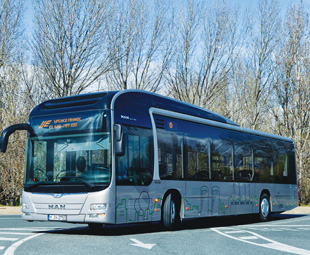Defining the bus of the future

FOCUS looks into its crystal ball to uncover some innovations that hint at the buses of the future
The bus of the future – what will it be? We’ve seen some new concepts in recent years (some of which are already in service in designated areas) that paint a picture of a passenger experience that is comfortable, connected, on demand and more attractive to the public transport user of the future than buses have ever been…
To truly figure out what the bus of the future might look like, however, we need to look at the innovations that are currently surfacing and the programmes that are already running.
Take the European Bus System of the Future 2 (EBSF_2) programme (which runs until April 2018) as an example. It seeks to test and evaluate innovative solutions for urban and suburban bus systems in real operational scenarios. These include energy management, green driver-assistance systems, vehicle design and the interface between the bus and its surrounding infrastructure.
The more than 500 vehicles across 12 European demonstration sites are in operation to improve the efficiency and image of bus transport among rapidly increasing urban populations that are, on the whole, rather apathetic to the concept of travelling by bus.
Electrified
 Bus manufacturers need to ensure that their products suit the systems – and the users – of the future. As we know, electric and hybrid drive is one of the most significant developments for public transport vehicles operating in cities that have increasingly stringent noise and air-pollution restrictions.
Bus manufacturers need to ensure that their products suit the systems – and the users – of the future. As we know, electric and hybrid drive is one of the most significant developments for public transport vehicles operating in cities that have increasingly stringent noise and air-pollution restrictions.
Development in this sector is advancing rapidly. The ElectriCity partnership for electrified transportation in Gothenburg, Sweden, is a collaborative project between academics, industry and the public sector, which is aimed at developing, demonstrating and evaluating new sustainable public transport systems for the future.
The ElectricCity partnership recently took first prize in the “operational and technical excellence” category at the 2017 UITP Awards.
“The restructuring of the transport sector is necessary if we are to succeed in creating a sustainable society and the cities of the future. Here sustainable public transport is an important puzzle piece,” says Niklas Gustafsson, chief sustainability officer, Volvo Group, which is one of two main partners in the project.
For MAN Truck & Bus, the “hybrid bus of tomorrow” is a current research project being run under the umbrella of the European Union’s Horizon 2020 Ecochamps project. MAN is constructing a hybrid bus driveline, which should be up to 20-percent more efficient.
“In the city-bus segment in particular, we are seeing huge potential for using eMobility applications. However, the total cost of ownership plays an especially significant role for transport operators and carriers,” explains Dr. Götz von Esebeck, head of eMobility at MAN Truck & Bus. “For this reason, we are working continuously to find both technical and economic improvements for our solutions.”
As part of this project, MAN is developing a concept for a basic vehicle with an electric driveline that, depending on customer requirements, can integrate different energy sources. The basic hybrid bus will be unveiled in the last quarter of 2017.
Scania, too, has entered the electric bus race. At the end of 2017, field tests will begin for three Scania Citywide LF buses for forthcoming battery-electric buses in the northern Swedish city of Östersund.
 It’s well known that the company offers a wide range of alternative-fuel buses and coaches. “By adding battery-electric buses, we will further strengthen our focus on sustainable transport and complement this broad range with buses particularly for inner-city operations,” says Anna Carmo e Silva, head of Scania Buses and Coaches.
It’s well known that the company offers a wide range of alternative-fuel buses and coaches. “By adding battery-electric buses, we will further strengthen our focus on sustainable transport and complement this broad range with buses particularly for inner-city operations,” says Anna Carmo e Silva, head of Scania Buses and Coaches.
“The introduction of battery-electric buses here is really exciting,” says project manager Anne Sörensson from the City of Östersund. “They will contribute to our aim of achieving fossil-free transport by 2030.”
Safe
While low – or no – emissions are not negotiable in the bus system of the future, buses will also have to be safer and more comfortable than ever. Since November 2015, emergency braking systems have been mandatory for newly registered heavy-duty coaches (and trucks) in Europe.
During 2018, Daimler Buses will introduce its new Active Brake Assist 4 (ABA 4) with pedestrian recognition; which, it says, is the world’s first emergency-braking assistance system in a bus to automatically brake for pedestrians.
The system comprises long- and short-range radar systems. The long-range radar registers multi-track vehicles and stationary obstacles at a maximum distance of up to 250 m in a direct line in front of the coach, single-track vehicles such as bicycles at up to 160 m, and pedestrians at up to 80 m. The short-range radar has a maximum range of 70 m and is also able to recognise pedestrians and vehicles in front and to the side of the coach.
On-demand
Uber with buses – think it could never work? Berlin-based CleverShuttle mobility service thinks otherwise, and it’s even attracted strategic investors such as Daimler Buses.
CleverShuttle runs an on-demand ride-sharing service in Berlin, Munich and Leipzig, Germany. The company offers the world’s first emission-free, on-demand urban driving service.
An intelligent optimisation algorithm bundles CleverShuttle passengers with similar routes into a single vehicle and drives them efficiently and inexpensively from door to door. The new on-demand software is based on the tried-and-tested technology from CleverShuttle and can be integrated into existing regular service routes.
The company has now joined forces with EvoBus GmbH to develop its business-to-business division.
Says Bruno Ginnuth, co-founder and MD of CleverShuttle: “We’re closing the gap between buses and taxis. Both have their own purpose, but in between them there was hardly anything available in Germany. Now we want to use our knowledge as a business-to-business solution provider.”
Customisable
Meeting customer requests for special parts can be challenging, but 3D printing is making it quicker, easier and more cost-effective to manufacture parts. 3D printing allows for complex, moving parts – traditionally consisting of several components – to be created in a single step and without extensive assembly operations.
In addition to avoiding the costs of manufacturing special production tools, additional savings arise for small-series (replacement) and special parts, which are produced and supplied in specific quantities.
Special and low-volume parts can be modified at will, adapted to customers’ special requirements and produced in a custom design, and delivered to them in a matter of days. This proves particularly economical in small series involving batch sizes from one to 50 units. It also allows for flexibility at a local level.
Published by
Focus on Transport
focusmagsa




 Big news from FOCUS on Transport + Logist
Big news from FOCUS on Transport + Logist


 !
Starting 1 April, every
!
Starting 1 April, every


 FUSO: Driving the Future of Mobile Healthc
FUSO: Driving the Future of Mobile Healthc



 A brand
A brand




 Wondering about the maximum legal load for a
Wondering about the maximum legal load for a 
 The MAN hTGX powered by a hydrogen combus
The MAN hTGX powered by a hydrogen combus

 Exciting News for South African Operators
Exciting News for South African Operators


